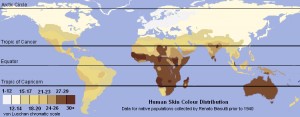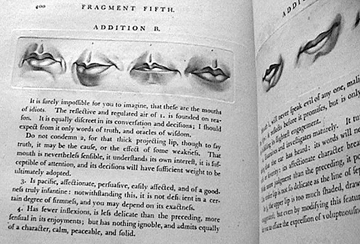In November 2015, English 291 students were asked to consider the history of physiognomy—the premodern science of deciphering a person’s character based on her appearance, including facial attributes, skin color, hair color, hairiness, motions, etc. For example, in the image above from Johann Caspar Lavater’s late 18th-century Essays on Physiognomy, Designed to Promote the Knowledge and Love of Mankind, the shape of some lips is taken to indicate discretion and others sensuality; some lips indicate persuasiveness and others affection. Sometimes physiognomy appears like race. Sometimes it doesn’t. But it always evokes a variety of reactions, and it seems to respond to a variety of disciplinary approaches to analysis.
At its most fun, obtaining knowledge is like a series of infinite regressions: in order to understand what one thing is a scholar must often seek to understand something else first, and so on. The rabbit hole goes down deep. In this case, “What Is Racial Difference?” occasions the question “What Is Physiognomy?” Only once we have attended to the latter question might we ask what race and physiognomy have to do with one another. It is in this vein that we, the denizens of English 291, begin our series on physiognomy with the next post: “Physiognomic Loopholes.”
Physiognomic Loopholes
by The Holistic Reviewer, A Student in English 291

Placing people in categories based on “race” is a convoluted business. The approach discussed by Kittles and Torres in their “Race and Genetics” provides valuable insight into the factors that influence our perception of race and its intersection with genetics. They push for identifying a person by her ancestry rather than by the race categories that humans have constructed based on culture, appearance, etc. This approach has important implications for matters involving a person’s health, such as when treatment for a certain condition may depend on the context of that person’s cultural predisposition to that condition. While taking an ancestral or genetic approach will be crucial for things that impact our health, I’m not so sure it will make any headway in terms of breaking down racial barriers; categorizing people is a practice that has continued for a very long time.
Racism makes its early appearance in what is known as physiognomy. The art of physiognomy relates various physical characteristics of a person and applies them to the moral or immoral behavior of that person. While some argue that it carries little weight in the development of racism, I view it as an early iteration of the practice of prejudging people based on appearances and with little regard to their backgrounds.
If we look at events today, hundreds of years after the advent of physiognomy in such texts as Pliny the Elder’s Natural History and the medieval Secretum Secretorum, we can see the traces of physiognomy still. The actual practice may no longer exist, but some of its characteristics still persist in social and cultural life today. Physiognomy contained loopholes that covered for its inaccuracies by saying that we have to consider all traits in a person when his behavior doesn’t match his physical characteristics; inconsistencies in how we categorize individuals reveal the manipulated ways in which people are divided. A recent incident took place at a Texas school, where a 14-year-old boy was arrested for bringing a homemade clock to school to show his teachers. Besides the absurdity of the event (as the protocol for law enforcement’s behavior would have been quite different if they truly believed the boy brought a bomb to school), this event highlighted how the idea of race is formed through the intersection of various criteria, such as region and nationality, religion, and appearance, to name a few. He is a Muslim boy of Sudanese ancestry, so his religion is heavily connected to the Arab ethnicity, while his Sudanese heritage connects him to Black African identity. Media attention stressed his Brown identity, although he could reasonably be described as Black. Discussions I had with my peers surrounding the event brought to light how certain identities are ushered to the forefront in order to match a particular scenario. Bombing is a crime associated with Brown Muslim terrorists, so this Brown boy narrative was pushed as a result. Categorizing people, as this and many other events like it show, is a long-time practice. If we do in fact take an ancestral approach, people will probably find another arbitrary way to categorize people in order to instill the idea that we aren’t the same beneath the surface.

